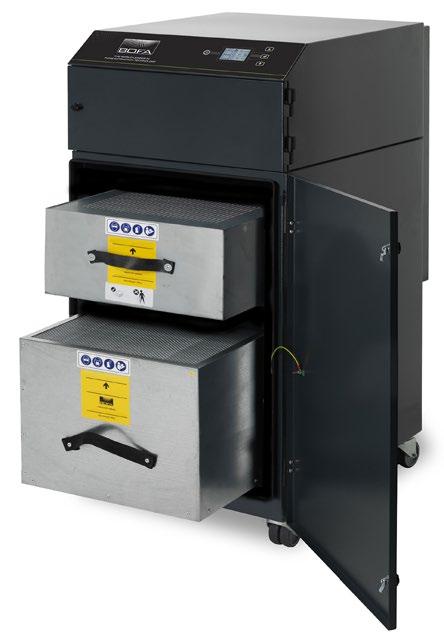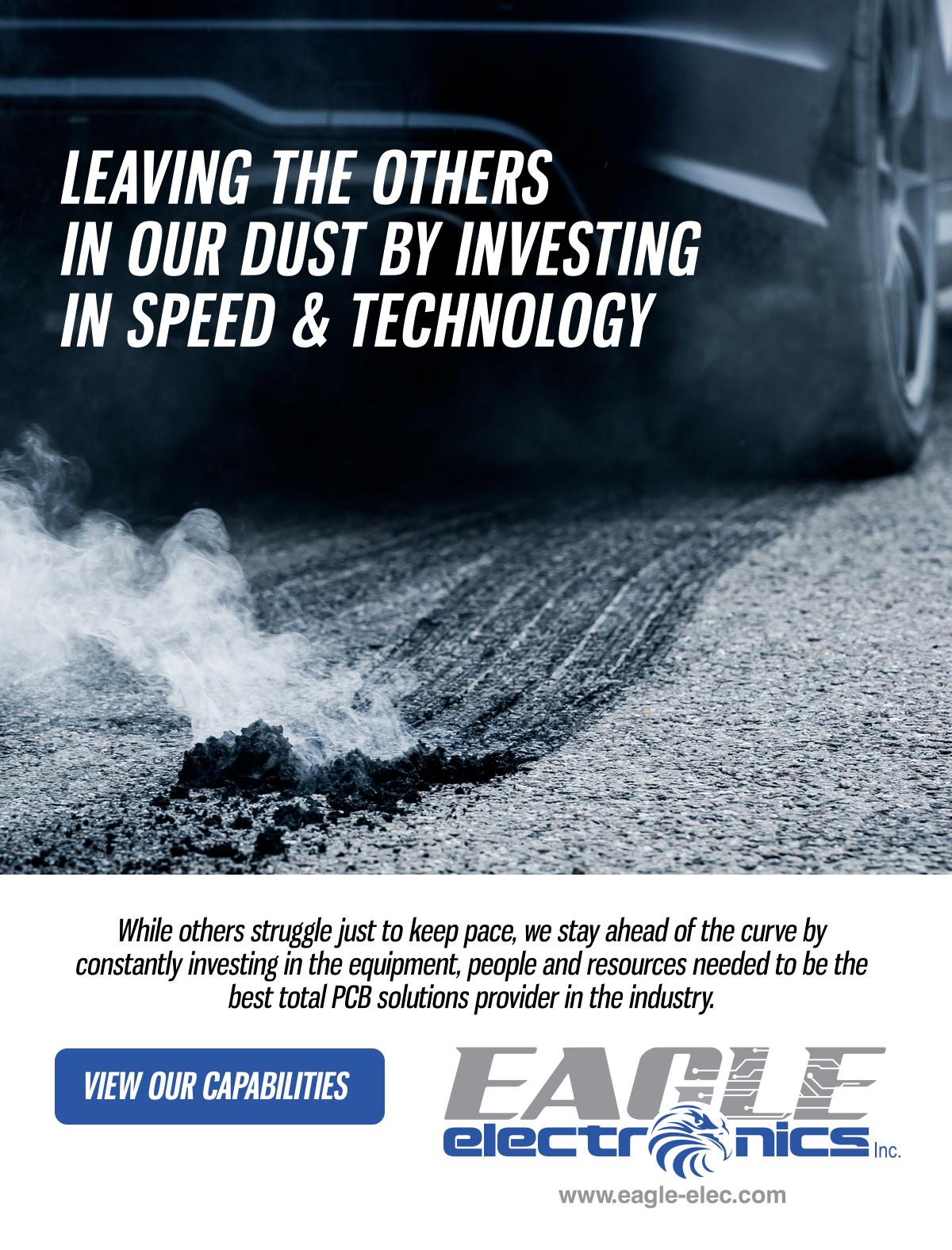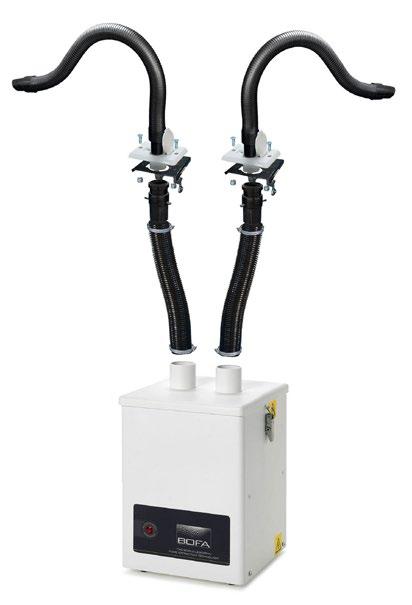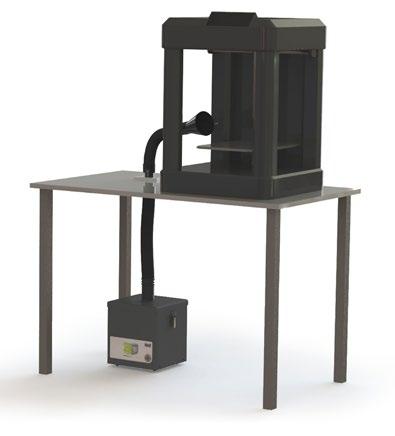
19 minute read
Fume Extraction in Electronics
from Croll6e
by Thomas Swift
Fume Extraction
in Electronics
Advertisement
Feature Interview by Nolan Johnson
I-CONNECT007
I spoke with BOFA’s Andy Mitchell about the current trends and challenges facing electronics manufacturing facilities with regard to fume extraction, fume management, and the current state-of-the-art soldering.
Nolan Johnson: Andy, introduce us to you and BOFA.
Andy Mitchell: My title is west regional sales manager. I’m responsible for both the technical side and the sales side for BOFA’s customers in about 12 western states. BOFA was originally founded in Poole, England, and we’re still headquartered in Poole. A lot of the local exhaust ventilation industry started in Europe and the U.K. because the EU had a lot of regulations that required it.
BOFA started about 33 years ago in the U.K. In the U.S., the company opened up the BOFA Americas division roughly 10 or 12 years ago. Probably the biggest footprint in the industry is in the laser coding and laser marking industry, then also the laser engraving and cutting industry. Those processes create a lot of fumes and particulates, that we’re able to capture, run through filters, and exhaust clean air back into the room instead of exhausting it outside.
That same technology then lends itself to a lot of other industries, with electronics being a big one as well with either soldering processes creating the fumes from the flux vapor and the odors from conformal coating or cleaning processes. Also, there’s some laser work in electronics as well, and then routing, removing boards from panels—both with a laser or even with a mechanical means; you create a lot of debris, and we have systems designed for removing that as well. With electronics, it’s mainly the soldering side, or the conformal coating and chemical side where they come into play. Then, two years ago, we were purchased by Donaldson Corporation out of Minneapolis, Minnesota, so that’s our parent company now. We’re BOFA-Donaldson Company.
Johnson: There are fume extraction issues in the PCB fabrication industry as well, what
Andy Mitchell


FumeCAB 700 ESD cabinet fume extraction solution for a broad range of anti-static applications.
with all the wet chemistries and the like. Do you have much presence in the printed circuit board fab facilities?
Mitchell: Not anything significant, and the wet part is the reason. The filtering technology we use doesn’t like to get wet. We can take the gas vapor coming off of those processes, but if it’s enough of a vapor that it’s going to condense back into any kind of liquid, it gets out of our main work area. We do get into the component side of it. There are a lot of applications in that, and most of those are dealing with lasers of some kind.
Johnson: Right, such as vaporizing a lot of solid materials. Tell me a little bit about the technology for doing what you do and managing those sorts of fumes and vaporized items. What are the concerns?
Mitchell: At its simplest description, we create airflow with a motor blower, or some people call them pumps, that makes the airflow that draws the air from whatever area you’re creating this material you want to filter. Let’s say it’s a laser and you’re going to create enough airflow to draw the air from the laser, hold it into the extractor, and then it goes through typically three phases of filtration, which the first phase is a pre-filter—typically something around a 95% efficiency at 0.8 microns. Relatively speaking, we’d call those the larger particulates. It’s going to capture those in the prefilter. The reason for the pre-filter is it’s going to take out most of the bigger stuff so that when you get to the next stage—which is the HEPA filter—you’ll have less material going into it because HEPA filters tend to be more expensive, so you don’t want them getting clogged up with large particulate that you can capture in a pre-filter first.
HEPA filters are 99.997% efficient at 0.3 microns, which is kind of the magic number people are worried about with the particulate size getting caught in your lungs and bloodstream, potentially causing a health hazard. The HEPA filter is designed to capture that material, and that’s your second stage. The third stage is going to be activated carbon, and that’s what’s going to capture the gas and the odor mainly of the material you’re working from. A lot of our extractors have two physical filters: the main filter case contains both the HEPA and the carbon. The prefilter is a separate filter case. There are two physical filter cases, but it’s looked at as three stages of filtration.
The entire extractor is going to have the pump that creates the airflow built into that; the electronics that control the settings, the speed of your pump, and then your filters are all put into the same extractor that allows you to have everything fully contained. Essentially, you plug this into a power source and connect a hose from wherever the source of the particulate or fume is generated. More than half of the products that we’re offering are being used at 120 volts. We have some of our larger units that require 220 volts, and we have one significantly larger unit that’s 440 volts.
Then, the hose runs back into the extractor, so it pulls everything into that and vents it back out generally into the room. You could add a port to it to vent it out somewhere else
if you wanted to, or—in some applications—to circulate the air back into whatever chamber you were pulling air out of so you can have a closed-loop system.
Johnson: Is this typically installed with one unit per hood, or is it built into the central HVAC system?
Mitchell: The systems that we manufacture are designed to be task-oriented. You’re going to put an extractor for each of those tasks. If you had five lasers that were all next to each other, and each laser needed about 200 CFM to pull the air out, you could put one extractor that’s generating 1,000 CFM. Typically, we put one extractor on each one of those units to leave you a lot more flexibility that way. This isn’t something that we’re going to hook up to an HVAC system and try to pull the whole building into it. We’re looking more at if you’re hand soldering and putting an extractor with that operator or at least a hood with that operator. If it’s an inline oven, we’re going to hook up one extractor per oven, and then lasers are the same thing.
Johnson: Talk more about the dangers of the particulate that’s being created: solder, solder fumes, flux, flux fumes, very small particulates, and vaporized solids from the lasers. What are the dangers to humans from those?
Mitchell: Essentially, you’re looking at lung and breathing issues. With some of the chemicals that people work with, there can be either health limits to the amount of that material or even sort of allergic reactions to different chemicals that you’re able to alleviate those.
Johnson: What are the current trends or challenges facing electronics manufacturing facilities with regard to environmental regulation and/or worker health regulation?
Mitchell: The first challenge is how you’re going to capture it. If you’re working with enclosed systems like lasers and ovens, it’s much easier. If you’re working with things that are more hand operations, you have to create ways to gather up that fume and particulate and get it drawn into an extractor.
Johnson: What are some implementations you see in the field right now?
Mitchell: If the unit that’s creating or processing the material is enclosed, that’s simple. There’s generally going to be a port that’s the vent, you connect the hose to it, and that hose also connects to our unit. If it’s more of an open process—maybe an operator at a workbench hand soldering, touch-up conformal coating, or any of those types of operator processes— you’re going to put either a flexible arm with a hood at the end of it that captures or have a smaller hood that you can configure onto the bench that creates the airflow and draws it in. The more enclosed that it gets, the better the capture is going to be—in part because you’re removing the variability of the operator. If you have an arm with a hood at the end—which has been used for capturing solder fumes for the longest time—they’re efficient when they’re in the right place. In the right place means the operator has to have the board and the hood close enough to each other that it’s drawing the fumes in.
Johnson: If you find that your work station is in a facility where you’re close to a door, for example, when that door opens and closes, it changes the pressure and causes air nearby to move horizontally; now, the hood is no longer doing the job.
Mitchell: Right, or an operator is warm, so they get a little fan and put it on their bench and blow the air on themselves across their work surface—not that I’ve ever seen that happen before (laughs).
Johnson: There has been a lot of development lately in solder technology—changes to the flux, using fluxes in different ways, etc. Solders have gone from containing a lot of tin and lead to lead-free solders, which has shifted the working temperatures. Of course, smaller and
smaller solder ball sizes are appearing in some mixtures. Do these changes play a part in what kind of products you need to deliver to electronics manufacturers?
Mitchell: I would say in the bigger picture, if I’m hand soldering with lead-free solder or tin-lead solder, how I capture it is pretty much going to be the same. That lead-free solder probably has a no-clean flux on it with low solids, so it’s putting out fewer particulates than the old tin-lead solder with 30% solids RMA flux, but I’m still going to capture that the same way. As things get smaller, in one small respect, you could say it makes it a little bit easier because you don’t have to try to cover as wide an area. Parts are getting smaller and the boards are not significantly shrinking unless the end-product is a small product like a cellphone or something like that.
Johnson: It’s the size of the grit that’s used in the solder.
Mitchell: That doesn’t affect what fumes and particulates come off of that. I’m going to
AD 1000 iQ laser fume extraction system shown with access door open. share something now that’s my opinion; BOFA hasn’t taken a position one way or the other on this, so I want to say it as my opinion and not BOFA’s. My background is in the soldering industry. I was in that for a long time, and I have always heard people talk about they’re worried about the fumes containing some metal. All of the studies I ever had seen conclude that isn’t the case. The fumes are the flux. There’s potential, theoretically, that some molecule of the solder could grab on to that flux particle that’s being vaporized and you’d get a little bit of that. I haven’t seen a study that said that’s happening. All of that’s to say that the size of the sphere of solder that’s used in a solder ball I don’t see it having much of an effect on what we’re picking up.
What has a much greater effect is all of the changes in the chemistry and the types of fluxes. Going to the no-clean flux, you have a lot smaller percentage of solids in that, which are what end up in a lot of that vapor that’s caused by it. Because we’re going to leadfree solders, they melt at a little higher temperature, and industry has kind of typically then said, “Everything needs to be done hotter,” which then causes a little bit more vaporization of that flux material. Or in a lot of hand soldering applications, you get people adding liquid flux to their flux-cored solder that kind of starts counteracting the no-clean that they were using. If you throw enough noclean flux on something, you’re going to need to clean it.

Johnson: Does that increase the filtration need, and do you have to go to different filters or move more cubic feet per minute?
Mitchell: It would still be the same types of filters. I would not say that it requires additional airflow, it doesn’t require a different filter set. It requires the attention to creating that capture area.
Johnson: When you go into a customer facility to talk to them about fume capture, how often do you find that the facility is adequately arranged? As far as the physics of setting up

their shop, do you find most facilities are adequate or is there room for improvement?
Mitchell: From the standpoint of capturing and filtering and reintroducing the air into the room, I’d say we see a lot of room for improvement with that. Our biggest competitor is still blowing the air out of the building onto your neighbors.
Johnson: That can’t be great for the environmental sorts of guidelines that are coming up.
Mitchell: Right. Especially in the electronic industry, the majority of the large ovens and conformal coating systems, and all of that is being vented out of the building. Hand soldering, I’d say a significant amount of that is being run through some type of a filter, a local exhaust filter, and part of that’s because all of the soldering iron manufacturers realized years ago that there was a great accessory they could be selling with their iron, which was some type of a capture system.
A number of companies manufacture a fume extraction capture system that they sell with their irons. They all work on essentially roughly the same process: the pre-filter, some type of a higher efficiency filter, possibly a HEPA. To remove odors/gas, some of them include a foam pad that’s impregnated with carbon; that doesn’t capture odors for very long. Some of them have activated carbon in them.
Johnson: There are a variety of levels and capabilities that are available.
Mitchell: Right.
Johnson: Your region includes the U.S. states California, Oregon, and Washington. These three states are known for being pretty aggressive in their environmental protection legislation. What are some of the legislative or environmental protection challenges that your customers in these three states are dealing with on a regular basis?
Mitchell: I would say they have more of a challenge with, or maybe more questions about, how to dispose of the filters once they’ve reached their end of life than they do about the necessity of using fume extraction. There seems to be less regulation on the environment that the operator works in than the disposal side of the industry.
Johnson: What are those challenges?
Mitchell: The basic questions that I get are, “Can I dispose of the filter, and if so, how?” My answer is when my filter is new, it doesn’t have anything in it that requires any type of special handling for disposal. It’s a stainless steel case with a glass paper filter, and activated carbon, which can be disposed of through any normal process. But once you start pulling in material to it, what I typically tell them is every municipality is going to have its own requirements. The best advice I can give to people is you want to treat that filter the same way you would treat the material you were processing that the filter has now absorbed or adsorbed, depending on what you were doing. Then, every time you change zip codes, your requirements could change a little bit.
Johnson: I have a filter I swapped out, and now I have to dispose of it. Perhaps this filter has come out of the hood over the laser router, and has collected material that is not safe for the general landfill. What do I do?
Mitchell: Probably the easiest way to say it is you’d be disposing of it the same way you dispose of any leftover material. It’s going to go through the normal process of disposing of material; which may indeed be your local landfill.
Johnson: The waste management chain that you already have in place, then?
Mitchell: Right. And then if you are working with some material that was a little bit more exotic, you’re going to have that same chain for that type of material. It might go through an incinerator process or something like that, but the easiest way to describe it is you’re
not going to have to do anything differently because it’s a filter, it has to be however you would have processed that material.
Johnson: Is it fair to assume that if a company is working with that material already that they’ve also set up an appropriate channel for disposal? Then they would use the same channel?
Mitchell: Right. I’m not adding complexity to that because that system would have already existed for what they were working with.
Johnson: What do you currently see as the biggest challenges for electronics manufacturers in managing fume extraction and the breathable air quality in their work environment?
Mitchell: I guess I would say the cost justification of filtering the air versus throwing it outside.
Johnson: Right. You have some major competitors that toss it outside, and if that’s good enough, then that’s good enough.
Mitchell: It’s “good enough as long as nobody complains,” they say. And then, once somebody complains, they start looking at alternatives. There are cost justifications; you have to dig a little deeper sometimes to find those, though. Take the example of manufacturing in Arizona. During blistering hot summers, you’re spending all this money to get the air temperature down in your facility to a manageable level where people are comfortable, and then you have a bunch of holes in your ceiling where you’re pouring that conditioned air out of the building with fans helping to pull it out of the building. Now, I have to pull new air into the building, re-cool it, and send it back out to the building. Where if you hook this up to a local exhaust ventilator, you’re not throwing the air out of the building; you’re going to pull it through these filters and exhaust it back into the building.
Johnson: It’s the same thing for preserving the heat inside for the colder climates, too. Mitchell: Exactly. That’s a more difficult calculation to make of how much that’s costing you. Maybe less obvious would be the way to say it. Another advantage you have with local exhaust ventilation is—especially with electronics manufacturing—when you put a plant together and run it for six months, and then your product mix or volume changes, you’re like, “I wish I had realigned or moved this line differently and had this oven over on a different side of the building, or even 30 feet away from where it is now.” If you’re venting out of the building, you’re calling the HVAC company, and they have to come and run a new line, or possibly even punch a new hole in the ceiling or a wall. If you run local exhaust ventilation, you unplug it from the wall, you roll it to where you want it now, and you plug it back into the wall for power.
Johnson: Do any of your products have sensors to monitor what’s in the air or any metrics about the air quality going into the air filters?
Mitchell: No, there’s not a before and after. There’s a sensor you can add into the exhaust

BOFA’s V250 Fume & Dust Extraction System.
The BOFA 3D PrintPRO 2 extracts fumes generated by the printer without causing the filament deposition area to be cooled. that’s looking for VOCs to let you know when it’s time to change the carbon. As the glass paper filters capture particulate, they start to restrict the airflow, so there are sensors built into it that are able to tell you as the filter’s getting full when it’s time to change that filter. As carbon gets saturated, it doesn’t change the airflow; it works like a sponge. You fill up a sponge with water, and if you pour more water into the sponge, it passes through. That’s what will happen with carbon eventually, so you can add a sensor into the exhaust that’s looking for a certain level of VOC to say, “It’s time to change it.” Of course, a lot of people also use their nose. Some VOCs have more odor, and your nose tells you right away when it’s passing through; they’ll change it then.
Johnson: Any parting comments within the context of fume extraction, fume management, and the current state of the art in soldering?
Mitchell: What we try to do with this equipment is to create not just a safe environment, but also a productive environment, less downtime with the equipment, less downtime with your operators, and using the filtering capability allows you to do that.
Johnson: That’s a pretty good claim. How does that help with the downtime? Mitchell: The particulates and fumes that are generated—such as with lasers—if you’re not getting the fumes and smoke pulled away adequately from the laser, it’s going to start to cause problems with your optics, which is going to cause more downtime as you have to stop to clean the optics every X number of hours. This is going to greatly extend that amount of time. Operators hand soldering with the potential for breathing, sinus issues, occupational asthma, and those types things—there will be less downtime for your operators if you’re properly removing the fumes and odors from their work environment. Working with routers and those types of things for removing boards, you have a lot of debris. Again, if you’re pulling that away from the equipment, but the equipment is able to go longer without requiring the maintenance of cleaning all that material out.
Where it’s taking off is both on the consumer side of it and even in the manufacturing industry side of it. The 3D printing industry is becoming quite an industry, both from the consumer hobbyist, such as people who have a little 3D printer at their home to companies that are making every kind of part you could ever imagine with 3D printing—they’re now 3D printing with both plastic and metal materials.
We find that’s sort of the industry where there’s a lot of education taking place now of the need for fume extraction. We see a lot of schools and universities realizing this—even elementary schools. You’re essentially heating up that plastic and liquefying it. It depends on which material you use and all of that, but some things would be better not to be breathed in; they are starting to look at the different ways to filter that so that you don’t contaminate your environment.

Johnson: That’s a good point because 3D printing technology is appearing in the electronics manufacturing sector much more readily.
Mitchell: Exactly.
Johnson: Thanks, Andy. SMT007








